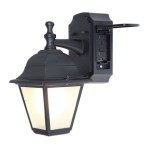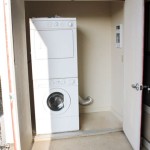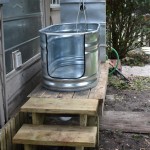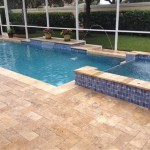Outdoor Solar Wall Lights With Motion Sensor: A Comprehensive Guide
Outdoor solar wall lights with motion sensors represent a practical and energy-efficient solution for enhancing security and illumination around residential and commercial properties. These devices leverage photovoltaic technology to convert sunlight into electricity, storing it in batteries for nighttime use. The integration of motion sensors allows the lights to remain off or dimmed until movement is detected, conserving energy and providing targeted illumination when and where it is needed most. This combination of features makes them a popular alternative to traditional hardwired lighting systems.
The functionality of outdoor solar wall lights with motion sensors relies on several key components working in concert. Solar panels capture sunlight and convert it into DC electricity. A charge controller regulates the flow of electricity to the battery, preventing overcharging and damage. Batteries store the electricity for nighttime operation. A motion sensor, typically passive infrared (PIR), detects movement within its range. Finally, a light-emitting diode (LED) provides illumination. When the motion sensor is triggered, the LED illuminates, providing bright light for a designated period before automatically switching off or dimming back down.
These lighting solutions offer a variety of benefits that contribute to their widespread adoption. Reduced energy consumption, ease of installation, and enhanced security are but a few. Understanding these advantages, alongside the factors to consider when selecting and installing these lights, is crucial for maximizing their effectiveness and longevity.
Key Considerations When Choosing Outdoor Solar Wall Lights with Motion Sensor
Selecting the appropriate outdoor solar wall light with a motion sensor requires careful consideration of several factors. Performance characteristics, environmental suitability, and overall construction quality are all important determinants of a light's effectiveness and lifespan.
Lumen Output and Illumination Area: The lumen output of the light, measured in lumens, indicates the brightness of the light emitted. A higher lumen output will provide brighter illumination and cover a larger area. Assess the size of the area you need to illuminate and choose a light with sufficient lumen output to meet your needs. Consider the light distribution pattern as well. Some lights provide a focused beam, while others offer a wider spread of light. The ideal choice depends on the specific application.
Motion Sensor Range and Sensitivity: The motion sensor's range determines how far away it can detect movement. Typically, motion sensors have a range of 10 to 40 feet. The sensitivity of the sensor affects how easily it is triggered. A higher sensitivity will detect even small movements, while a lower sensitivity may only detect larger movements. Adjustability of the sensitivity and range is a valuable feature, allowing you to customize the light's response to your specific environment and reduce false triggers from small animals or swaying foliage.
Battery Capacity and Lifespan: The battery capacity, measured in milliampere-hours (mAh), determines how long the light can operate on a single charge. A higher battery capacity will provide longer run times, especially during periods of limited sunlight. The lifespan of the battery is also an important consideration. Batteries degrade over time and will eventually need to be replaced. Lithium-ion batteries are commonly used in solar lights due to their high energy density and long lifespan, but other battery types may also be employed.
Solar Panel Size and Efficiency: The size and efficiency of the solar panel directly impact the light's ability to charge its battery. A larger and more efficient solar panel will capture more sunlight and charge the battery faster. Look for lights that use monocrystalline or polycrystalline solar panels, as these are the most efficient types available. Amorphous silicon panels are less efficient and may not be suitable for areas with limited sunlight.
Weather Resistance and Durability: Outdoor solar wall lights are exposed to the elements and must be able to withstand rain, snow, sun, and extreme temperatures. Look for lights that are rated IP65 or higher for water and dust resistance. The Ingress Protection (IP) rating indicates the level of protection against solid objects (dust) and liquids (water). The higher the numbers, the greater the protection. The housing material should also be durable and resistant to corrosion. Common materials include ABS plastic, aluminum, and stainless steel.
Adjustable Settings: Many outdoor solar wall lights offer adjustable settings that allow you to customize their operation. These settings may include adjustable motion sensor sensitivity, adjustable light duration (the length of time the light stays on after motion is detected), and different light modes (e.g., dim mode, bright mode, off mode). These adjustable settings provide greater flexibility and control over the light's performance.
Advantages of Using Outdoor Solar Wall Lights with Motion Sensor
The appeal of outdoor solar wall lights with motion sensors stems from a convergence of economic, environmental and safety benefits. These lights provide a sustainable and cost-effective solution for outdoor illumination, while also contributing to enhanced security and convenience.
Energy Efficiency and Cost Savings: Solar-powered lights eliminate the need for traditional electrical wiring, resulting in significant energy savings. By harnessing solar energy, these lights reduce reliance on the electrical grid, decreasing your carbon footprint and lowering your electricity bills. The motion sensor feature further enhances energy efficiency by only illuminating the light when necessary, conserving battery power and extending the light's lifespan. Over time, the savings on electricity costs can more than offset the initial purchase price of the lights.
Easy Installation and Maintenance: Unlike hardwired lighting systems, solar wall lights are easy to install. They do not require any electrical wiring or professional installation. Simply mount the light on a wall or other surface using screws or adhesive. This makes them a suitable option for DIY homeowners. Maintenance requirements are also minimal. Periodically cleaning the solar panel to remove dirt and debris will ensure optimal performance. Battery replacement may be necessary after several years of use, but this is a relatively simple and inexpensive task.
Enhanced Security and Safety: Outdoor solar wall lights with motion sensors can significantly enhance security and safety around your property. The sudden illumination of the light when motion is detected can deter potential intruders. The bright light can also illuminate walkways and pathways, reducing the risk of accidents and injuries. By providing targeted illumination where and when it is needed, these lights can create a safer and more secure environment for you and your family.
Environmental Benefits: As solar-powered devices, these lights contribute to a more sustainable environment. They reduce reliance on fossil fuels and lower carbon emissions. By using renewable energy, solar lights help conserve natural resources and protect the planet. They also eliminate the need for disposable batteries, further reducing environmental impact.
Aesthetic Appeal: Beyond their functional benefits, outdoor solar wall lights can also enhance the aesthetic appeal of your property. They are available in a variety of styles and designs to complement any architectural style. From modern and minimalist to traditional and ornate, there is a solar wall light to suit every taste. Strategic placement of these lights can highlight architectural features and create a welcoming ambiance.
Installation and Maintenance Best Practices
Maximizing the performance and longevity of outdoor solar wall lights with motion sensors hinges on proper installation and consistent maintenance. Following best practices ensures optimal solar energy capture, efficient operation, and prolonged lifespan of the lighting system.
Optimal Placement for Sunlight Exposure: The location of the solar panel is crucial for optimal performance. The solar panel should be placed in a location that receives direct sunlight for at least 6-8 hours per day. Avoid placing the light under trees or other obstructions that may block sunlight. South-facing locations typically receive the most sunlight, but east- or west-facing locations may also be suitable depending on the specific location and time of year. Consider the angle of the sun and the shadow patterns throughout the day when selecting a location.
Proper Mounting and Securing: Ensure the light is securely mounted to a stable surface. Use appropriate screws or adhesive for the type of surface you are mounting to. For heavier lights, consider using wall anchors to provide additional support. Make sure the light is level and properly aligned. A poorly mounted light can be damaged by wind or other weather conditions.
Regular Cleaning of Solar Panels: Dust, dirt, and debris can accumulate on the surface of the solar panel, reducing its efficiency. Regularly clean the solar panel with a soft cloth and mild soap. Avoid using harsh chemicals or abrasive cleaners that could damage the panel. A simple wipe-down every few weeks will help maintain optimal performance.
Battery Maintenance and Replacement: The battery is a critical component of the solar light. Over time, batteries degrade and lose their capacity. If you notice that the light is not staying on as long as it used to, or that it is not as bright, it may be time to replace the battery. Follow the manufacturer's instructions for battery replacement. Use the correct type of battery and ensure it is properly installed. In colder climates, bringing the lights indoors during extended periods of freezing temperatures can prolong battery life.
Motion Sensor Adjustments: Fine-tune the motion sensor settings to meet your specific needs. Adjust the sensitivity and range to reduce false triggers and ensure that the light activates when it is needed most. Experiment with different settings to find the optimal configuration for your environment.
Seasonal Adjustments: The amount of sunlight available varies throughout the year. During the winter months, when there is less sunlight, you may need to adjust the light's settings to conserve battery power. Consider reducing the light duration or using a lower light mode. You may also need to clean the solar panel more frequently, as snow and ice can accumulate on the surface.
By adhering to these installation and maintenance best practices, users can ensure the prolonged effectiveness and efficiency of their outdoor solar wall lights with motion sensors. These considerations will help maximize the benefits of utilizing solar technology for outdoor lighting needs, providing safety, security, and energy savings for years to come.

Cgc Francis Slim Black Solar Led Outdoor Wall Light With Pir Motion Se Interiors

Solar Led Wall Lights W Motion Sensor For Outdoor Lighting

Welcome Solar Led Flush Wall Light With Pir Sensor Set Of 2 Lighting Direct

Outdoor Waterproof High Lumen Modern Motion Sensor Activated Wall Lamp Garden Led Solar Light Interior Made In Com

Brimmel Solar Sconce Lights Outdoor Motion Sensor Wall Big Size 10hours Battery Life Waterproof Lantern For Porch Front Doo

Solar Lights Outdoor 100 Led Super Energy Saving Iposible Motion Sensor Security 270º Light Range Wall Powered Wireless Waterproof With 3 Modes For Garden Outside Temu

Solar Lights Outdoor 100 Led Super Bright Motion Sensor Light 270 Wide Angle Wireless Waterproof Security Ip65 Wall For Front Door Yard Garage Deck Pathway Porch 5 11 X 3 7

Motion Sensor Solar Powered Wall Lamp Outdoor Garden Security Led Lights Motif Light Decoration Made In Com

Sabik Outdoor Solar Up Or Down Wall Light Anthracite Bhs

Litzee Solar Lights For Outdoor With Motion Sensor High Quality 100led 1000lumen Light 2200mah Waterproof Wall Led Garden 2 Piec








